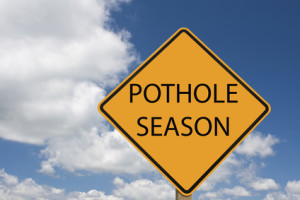 For those of us in Northern states driving in the car on these early days of Spring, we play a game of Concentration trying to remember every pothole to avoid to make it home safely. The road to retirement can feel very much the same way. Suddenly the smooth path you planned for turns into a bunch of craters. Once you finally get to retirement though, you think you’re home free. But those darn potholes don’t just end because you made it to retirement. The comfortable ride you saved for can suddenly get uncomfortable. Here are my top 7 potholes that retirees must watch for while in retirement.
For those of us in Northern states driving in the car on these early days of Spring, we play a game of Concentration trying to remember every pothole to avoid to make it home safely. The road to retirement can feel very much the same way. Suddenly the smooth path you planned for turns into a bunch of craters. Once you finally get to retirement though, you think you’re home free. But those darn potholes don’t just end because you made it to retirement. The comfortable ride you saved for can suddenly get uncomfortable. Here are my top 7 potholes that retirees must watch for while in retirement.
1. Health Care. According to a study by the American Institute of CPAs, 76% of financial planners, many of whom serve high-net-worth individuals, named health care costs as one of the chief factors causing their clients stress about outliving their money. Even when you’ve planned for these expenses better than you think, it’s hard to not be worried when you hear some of the numbers. A recent study found the average expected retirement health care costs for Medicare B, D and Supplemental insurance for a healthy couple retiring this year at 65 years of age will be $266,589 in today’s dollars. For a couple retiring in 10 years at 65, expected costs will rise to $320,996. If you factor in expected dental, vision, hearing, co-pays and all other out-of-pocket expenses, total projected retirement costs rise to $394,954 for a couple retiring today or $463,849 for the couple retiring in 10 years. These costs do not include long-term care. According to LongTermCare.gov, 70% of those over 65 will need some kind of long-term care service eventually. The average annual cost of a private room in a nursing home is now at $91,250. (Source: Genworth) You can pass on those costs to an insurance company by purchasing long-term care insurance, but that means added insurance premiums that could increase in the future.
2. Housing. For those of you living in cold winter locations, becoming a snowbird in your retirement years may sound very appealing. Buying a second home or renting a place seasonally can be a great way to get relief from the brutal winter and still remain close to family the rest of the year. Of course, this comes at an additional expense that you may not have considered as part of your original retirement planning. This includes mortgage/rent, utilities, taxes, maintenance and repairs, property management (lawn care, security, etc.), travel to and from the homes, and other expenses. Of course, even if you only have one home, you should consider costs related to retrofitting your home to make it more accessible as you age. A 2014 study found that while 96% of respondents say it’s important to be as independent as possible as they get older, only 21% of them planned to incorporate technology solutions, or to remodel and retrofit their homes in order to stay in place as they age.
3. Vacation. After working all those years and foregoing those special trips, you now want to see the world. However, those bucket list vacations require a lot more cash than you might have anticipated. You should also take into account regular travel to visit families and friends because you or they might have moved away. And remember that while you’re gone, you still have costs to maintain your residence.
These first 3 areas can add significantly to your expenses so it’s important to consider them as part of your retirement planning.You want to enjoy your retirement and feel secure in the amount you are spending. In our next post, we’ll cover 4 more potholes to avoid in your retirement.
Great post. Is going to be back for more quality information.